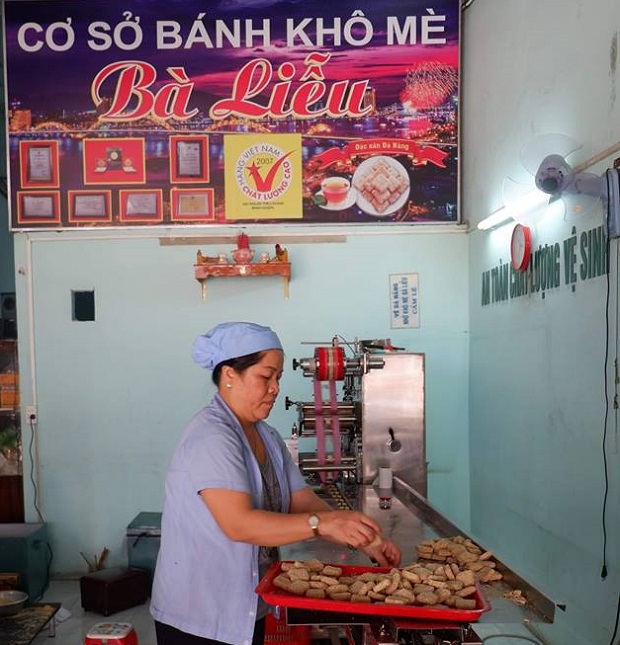Preserving traditional crafts
As newer generations turn away from the country’s hallmark crafts, there are still special practitioners in Da Nang who have been fighting in a silent manner to revive their time-honoured traditional crafts handed down through historical periods by their predecessors.
 |
| The making of dried sesame seed cakes in progress at Hai's facility |
Ba Lieu family-run business’s ‘banh kho me’ (dried sesame seed cakes), whose production facility was once located on the northern side of the Cam Le Bridge, is one of the city’s specialities.
Last year, 50-year-old Le Van Hai, Mrs Huynh Thi Lieu's oldest son, retired from his high-paid jobs as a civil engineer so as to assist his mother in maintaining the operation of a ‘banh kho me’ making establishment due to her ill health triggered by her old age.
Hai’s decision, indeed, clearly demonstrated how important this traditional craft is to his family, and he has still practiced the craft in a desperate attempt to preserve it, despite life’s ups and downs.
In regard to their secret recipes, Hai revealed, the cakes are made from glutinous flour, rice flour, granulated sugar, ginger, and sesame seeds. The rice flour is mixed with the glutinous flour, then poured into a mould to be steamed and then dried.
Next, the cakes are coated in sugar or sesame. The ones that are coated in sugar are called ‘kho no’, whilst those coated in sesame are called ‘kho me’. The delicious cakes are soft with well-dried sesame, and when they are broken the sugar must be like thin yellow silk cords.
Local families usually put these cakes on their altars on the death anniversaries of their relatives or at Tet.
However, Hai’s family is now facing some difficulties in doing business, especially since his ‘banh kho me’ making establishment moved into an over 100m2 land lot in a new residential area from the 1,200m2 previous site located on the northern side of the Cam Le Bridge due to the impact of local urban development projects.
Currently, a total of only 1,000 cakes are sold out per day, 10 times lower than in previous years.
Hai hoped that his family would be allowed by the local authorities to lease the former site of their production facility. He is also planning to invite visitors arriving in the city to experience interesting experiences in making ‘banh kho me’ by themselves at his facility.
Cam Le ‘banh kho me’ has made it into the list of the top 10 most well-known Vietnamese gift specialities. Visitors to this village can buy these cakes and give them as gifts to their relatives and friends. Today, the cakes are sold across the whole country, as well as abroad.
Although there are many different types of ‘banh trang’ rice paper, Tuy Loan area’s is the most famous because of its unique method of production and its amazing flavours of garlic and ginger. It has become very popular with local residents and both domestic and foreign visitors.
Despite her old age, Dang Thi Tuy Phong, 80, from Tuy Loan Dong Village, Hoa Phong Commen, Hoa Vang District, has continued with her endeavours to keep the craft of making rice paper.
Mrs Phong noted, in order to make the tasty rice paper, deliciously scented rice from the winter-spring crop is used.
Tuy Loan’s rice paper tastes very different from similar products produced elsewhere thanks to its special recipe which includes various spice mixes such as dipping sauce, salt, sugar, garlic, and sesame.
She always dries her products on charcoal fires instead of drying them in the sun, which prevents any mould formation.
More recently, a total of 30 million VND from the municipal Department of Agriculture and Rural Development has been granted to Mrs Phong’s own rice paper making establishment to support her to purchase flour milling and vacuum machines, and develop new packaging products.
It fact, it is their special love for the traditional crafts that has kept highly devoted practitioners like Mr Hai and Mrs Phong going through challenges and hardships to maintain the vitality of locally-made specialities, hereby preserving the quintessential cuisine of the Quang Nam-Da Nang land.